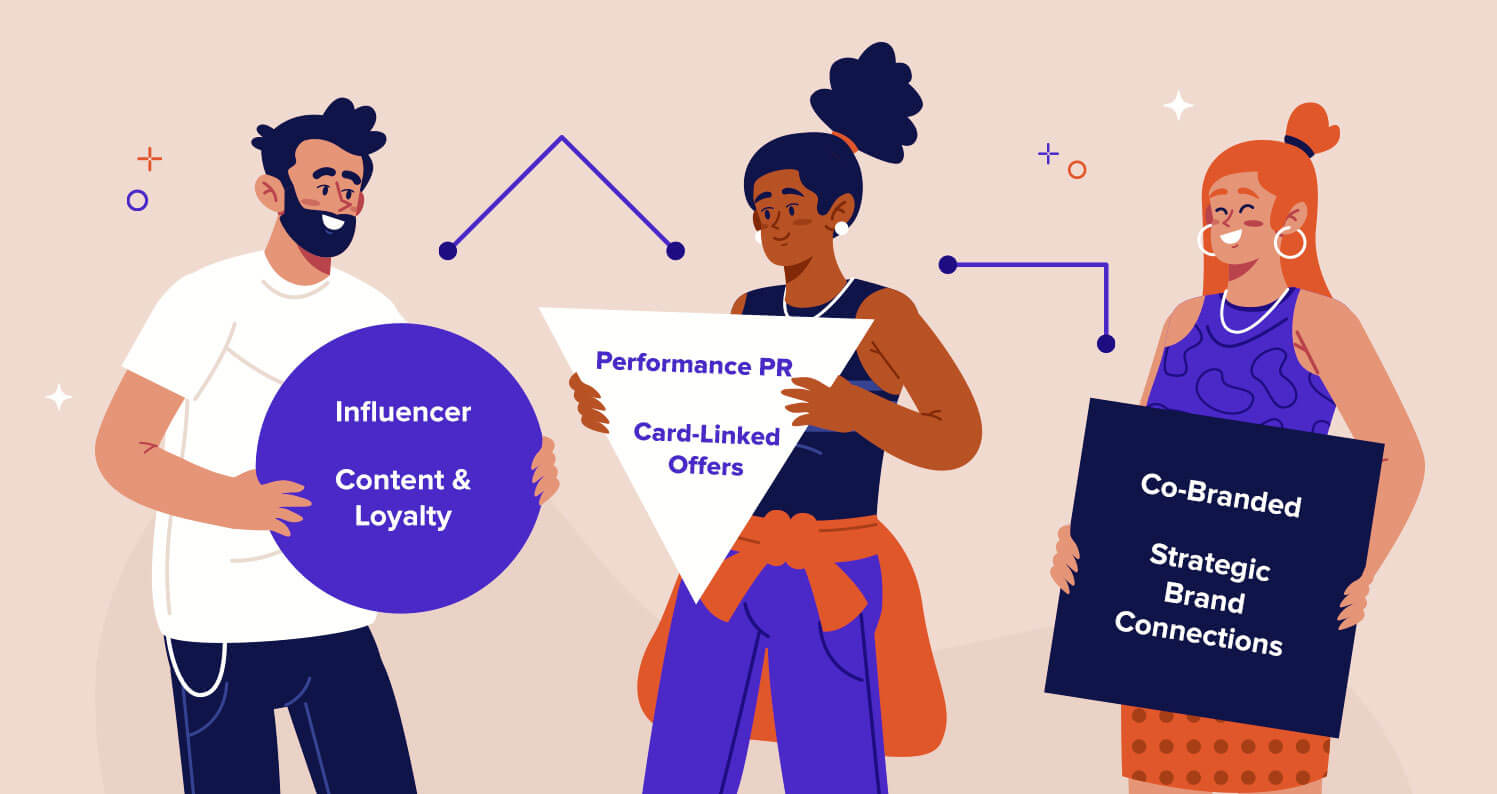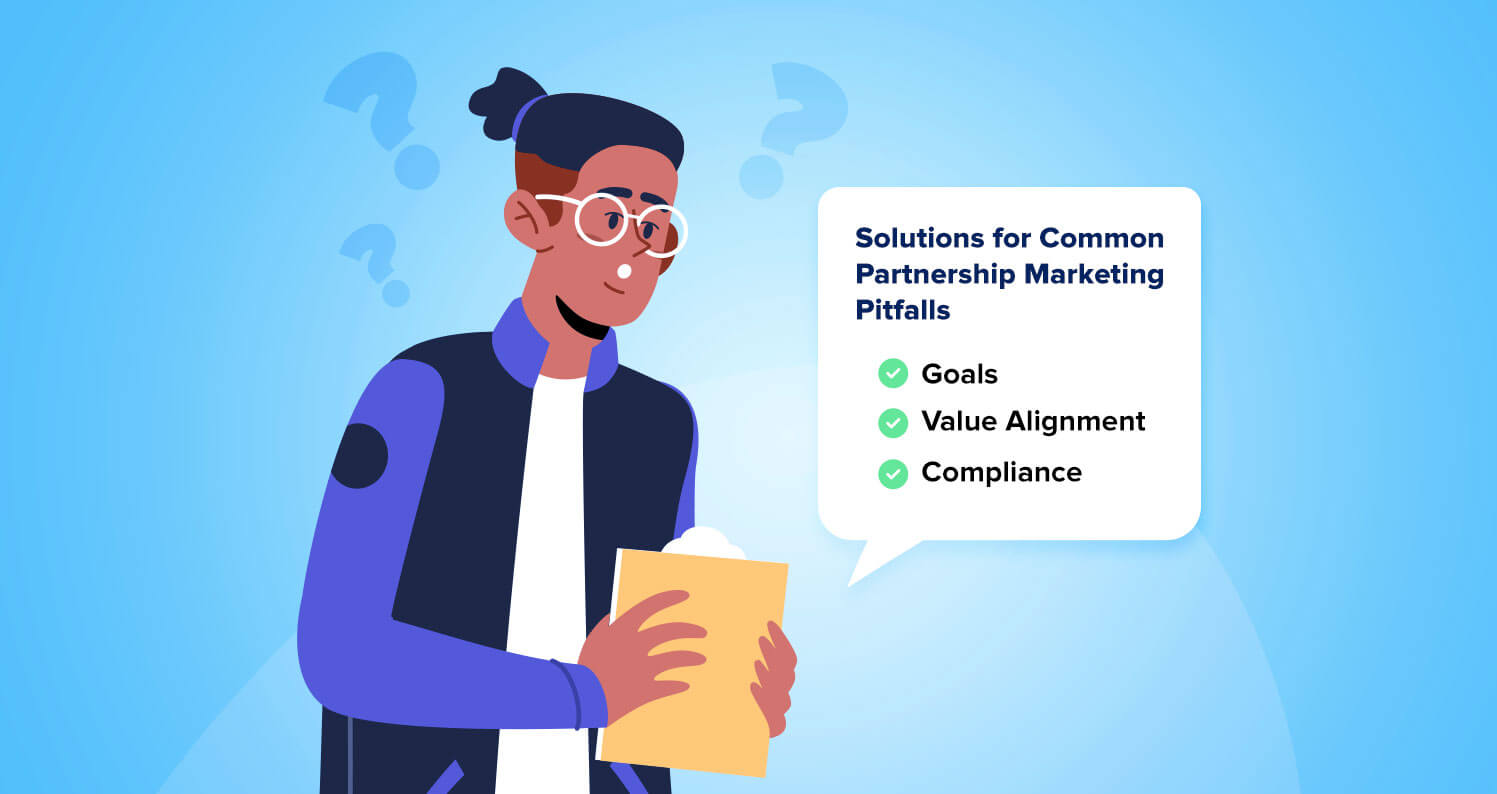Partnership Marketing: The Ultimate Guide
Partnership marketing is reshaping how brands scale reach, trust, and revenue. In this guide, we break down why it works, how to leverage it, and how to get it right.

Partnership marketing has been a tactic since the rise of the internet and ecommerce in the late 1990s.
At its core, it’s a strategic collaboration between two or more brands that “partner” to grow their audience. Together, they can increase reach and create value that neither might achieve alone.
Partnership marketing is not just co-branding, and it’s not just influencer marketing.
It’s not limited to performance-based affiliate campaigns, either.
So… what is it?
In this article, you’ll get answers to the most common questions we hear about partnership marketing. By the end, you’ll know exactly how to apply partnership marketing best practices to grow your brand.
Of course, if you have a specific question, you can jump straight to the relevant section using the table of contents below.
- What’s Partnership Marketing?
- Types of Partnership Marketing
- Partnership vs Affiliate Marketing
- Partnership vs Traditional Marketing
- Top Benefits for Brands
- Pitfalls of Partner Marketing
- Omnichannel Strategy Integration
- Key KPIs for Partnership Marketing
- Measuring Success
- Finding a Partnership Marketing Agency
What is partnership marketing?
Partnership marketing (or partner marketing) is the umbrella term for any mutually beneficial arrangement where businesses share resources, content, customer access, distribution, and—most importantly—ideas to achieve shared KPIs.
Where traditional or speciality marketing tactics may operate in silos, partnership marketing feeds on collaboration. It can be a:
- Co-produced piece of content.
- Joint product launch or collaboration.
- Integrated tech solution.
- Loyalty program that shares customer rewards across brands.
When done right, partnership marketing generates credibility, reach, and shared performance accountability.

Your brand may apply one or more types of partnership marketing to achieve success in the channel.
What are the different types of partnership marketing?
Partnership marketing isn’t a single process. Think of it as an eclectic playlist, and the best brands know how to get the most from it.
Depending on your business goals, a partnership can look like… well, a lot of things!
Influencer-led Collaborations
A creator introduces your product to their engaged audience through content that feels organic, not promotional.
No affiliate link? Don’t panic!
Awareness comes first. Influencers spark awareness that drives real clicks, conversations, and conversions.
Performance PR & Commerce Content
Think editorial placements in high-authority outlets:
- CNN Underscored
- BuzzFeed Shopping
- com
These partnerships deliver top-of-funnel visibility and sales through earned or paid content, especially when supported by affiliate terms or flat-fee campaigns.
Are you wondering where performance PR fits into this world? More than awareness, it connects editorial visibility to measurable outcomes when integrated with a good affiliate strategy.
Explore this in our new research-backed study on how editorial strategy drives full-funnel results.
Co-branded Campaigns
When two brands align on values, audience, or product collaboration, they can go to market together. Think email swaps, joint product launches, or dual-branded promotions. Each one starts form shared goals and aligned audience value.
Card-Linked Offers & Fintech Integrations
For brands in the travel, finance, or lifestyle space. Integration with loyalty or cashback platforms like Airtime Rewards or Klarna delivers honest value to consumers and measurable results to the brand.
Content & Loyalty Opportunities
Work with loyalty platforms or high-volume publishers who specialize in reward-based engagement, such as Rakuten Rewards, TopCashback, or even an employee benefits portal. This can drive repeat purchases and boost lifetime value.
Strategic Brand Connections
These are the high-impact partnerships that fuel long-term brand growth. Full-funnel partnerships where brands combine audiences, content calendars, and even budget to tackle new markets, sometimes without a commission structure in place.
What’s the difference between partnership marketing and affiliate?
We live and breathe affiliate marketing from every corner of the globe at Gen3. Affiliate is a massive, often misunderstood, subset of partnership marketing.
The affiliate channel runs on performance. Every click, conversion, and payout is trackable.
In action, a publisher promotes a brand’s product or service. This is typically in exchange for a commission or resulting conversions. The entire relationship is defined by data-tracked links, referral codes, cookies, and attribution models.
But wait! Not all partnership marketing is affiliate marketing.
While affiliate is usually built on conversion-based outcomes, partnership marketing goes beyond direct sales. It includes collaborations that aren’t always tied to a click or even a sale, such as:
- Co-branded campaigns with no commission.
- Influencer-led awareness plays.
- Sponsored content or education-based initiatives.
- Strategic alliances that build trust and audience engagement.
So, how does affiliate fit into the bigger picture of partnership marketing?
In the words of Gen3 Marketing Associate Director, Alan Holder:
“Affiliate is a tactic. Partnership Marketing is the strategy that frames it.”
More than just managing affiliate programs, the Gen3 team architects them to scale. Our performance-first mindset and decades of experience mean we build campaigns that work across every partner model.
We craft broader partnership opportunities that span the world of influencer, media, content, loyalty, and more. It’s a long-term project, delivering growth through smart partnerships and attribution.

Affiliate is a tactic, but partnership marketing is the bigger strategy that drives growth, trust, and collaboration.
What distinguishes partnership marketing from traditional marketing?
Traditional marketing channels are often brand first.
Paid media is budget first.
Content marketing is channel first.
Meanwhile, partnership marketing is relationship first, and that’s how it thrives. It’s a marketing strategy anchored around what can be done with your own budget, team, or channels.
It shows how relationships fuel brand growth.
This doesn’t mean it replaces paid search, display, email, or even social. Instead, it strengthens them.
You are still running campaigns, but now you’re doing it in tandem with a new partner. This partner might have access to a new audience, a unique distribution channel, or maybe content that tells your story in a way your in-house team never could.
The other big difference?
Traditional marketing is often a big part of your cost center. You pay for impressions, clicks, or even your own time. Partnership marketing leans into shared risk and shared return. It drives mutual results, rewarding both brands for performance, alignment, and trust.
It gives brands limitless opportunities.
Performance Marketing does look good in the mirror. As this powerful strategy flexes, it adapts to the partner(s), the audience, and the moment.
Gen3 Senior Vice President, Bruce Clayton, does a great job of putting it into context:
“The sphere of performance marketing continues to expand, encompassing an ever-wider choice of partners and opportunities. This opens possibilities for rewarding partnerships involving mass media content, influencer awareness, and card-linked offers. When the brand and opportunity align, powerful alliances emerge, driving both brand impact and revenue.”
What are the biggest benefits for brands?
Partnership marketing creates value in a way few other tactics can. It helps you outperform with the resources you already own.
Your new partner will provide access, trust, or coverage you don’t carry organically. In return, you bring them content, product, or performance they need.
The final score? Campaigns that work harder, cost less, and reach further.
At a time when media spend is on the rise and consumer trust is fractured, partnership marketing offers something different: Scalable, sustainable growth based on real connections.
Time and time again, marketers leverage partnership strategies for…
Extended Reach
Instead of paying to rent an audience through media spend, you now tap into a partner’s existing community. Ideally, one that has already established trust.
Cost Efficiency
Whether you’re working on commission, flat fees, or value exchanges, partnership campaigns are often more budget-flexible than traditional paid media.
Performance Accountability
Unlike brand campaigns that lean into awareness metrics, partnership marketing is built to drive traffic, conversions, revenue, and brand impact.
Content Credibly
A partner’s voice—be that of an influencer, publisher, or co-branded—carries more weight than self-promotion. More than impressions, you gain powerful endorsements.
Channel Diversification
For most affiliate-heavy programs, partnership marketing is a way to extend past cashback and coupons by leaning into content, loyalty, fintech, media, and more.
To quote Sophie Webber, an Affiliate Manager here at Gen3 Marketing:
“Partnership affiliate marketing is more cost-effective and results-driven than other forms of marketing because it emphasises performance-based partnerships, in which affiliates are only compensated when they generate a particular activity, such as a sale or lead.”

Partnership marketing isn’t one-size-fits-all. The best solutions are tailored to a brand’s needs.
What are the pitfalls of partner marketing (and how do you avoid them)?
Partnership marketing sounds great—and it is—but let’s be clear: It isn’t exactly “plug and play.”
Compare it to paid media. You control the budgets, the message, the timeline. With partnership marketing, you’re working alongside someone else. Strategic alignment is non-negotiable and requires proactive collaboration.
Even high-potential partnerships can fall flat without the right structure. That’s why Gen3 guides brands through every phase—from partner vetting to attribution modeling—to ensure lasting results.
Misaligned Goals
If both sides aren’t chasing the same outcome, whether that’s awareness, sales, or leads, the campaign loses direction very quickly.
Imbalanced Value
When one partner delivers significantly more than the other, tension can build. Whether it’s reach, investment, or effort, value should be defined and mutually clear from day one.
Attribution Complexity
Partnership efforts often span multiple channels (social, content, email, affiliate) which can create tracking blind spots. Without the right setup, it’s hard to prove what moved the needle.
Compliance & Brand Control
Compliance is a big deal, especially in regulated or sensitive verticals. Marketers need safeguards in place to ensure partners stick to messaging, visuals, and claims that reflect your brand appropriately.
Time & Resource Demands
Partnership isn’t always obedient. It takes relationship management, contract negotiation, content alignment, and campaign coordination. Brands that underestimate the lift required often stall out before they see results.
Every marketing strategy has its pitfalls, partnership marketing included. Fortunately, with the right strategy and team, the upside is huge.
As we’ve already discussed: Strategy matters, but execution matters more.
How do you integrate partnership marketing into an omnichannel strategy?
Partnership marketing isn’t a standalone effort. It’s a channel-agnostic strategy that works across the full digital marketing mix—paid, owned, and earned.
With thousands of partnerships under our belt, Gen3 knows exactly where each model performs best, whether driving awareness through editorial or converting through loyalty and cashback plays. For example:
- A commerce article on CNN Underscored might generate traffic that feeds into your retargeting agenda.
- A loyalty-based cashback offer might drive repeat purchases in partnership with your Customer Relationship Management (CRM) efforts.
- Influencer campaigns can boost brand relevance in social while indirectly supporting SEO through content syndication.
With experience across every publisher model, from mass media to loyalty, our experts know how to align each partnership with the stage of the funnel where it performs best.
Partnerships will always bring continuity to fragmented journeys. They will amplify your brand across platforms you don’t own, but where your targeted audience already spends time.
Likewise, when integrated correctly, they support paid media, reinforce SEO, and unlock incremental traffic through new touchpoints.
One of Gen3’s beauty brand clients broke into the US market by doing exactly that. Combining editorial partnerships, timed promotions, and strategic offers drove performance without relying on paid media alone.

Common pitfalls in partnership marketing—like misaligned goals, unclear value, or compliance issues—are avoidable with the right strategy.
What are the key KPIs to track in partnership marketing?
Don’t be fooled, the strength of partnership marketing isn’t just in its reach. It’s also rooted in measurability.
Every partnership must tie directly to measurable outcomes, whether through affiliate, media, or influencer channels. But unlike traditional channels, partnership marketing can show its worth across the funnel, which should be represented in your KPIs.
Top-Funnel KPIs (Awareness & Engagement)
- Impressions & Reach: Understand how far your brand is existing through partner placements.
- Engagement Metrics: Track clicks, scroll depth, social shares, and time on page for content-led or influencer campaigns.
- Referral Traffic: Where is traffic coming from? How long are those users staying?
Mid-Funnel KPIs (Consideration)
- New vs. Returning Visitors: Are partnerships introducing net-new audiences or deepening existing ones?
- Content Interactions: Measure CTA clicks within co-branded content or editorial placements.
- Lead Submissions: Particularly in B2B or lead-gen campaigns, partners can drive direct form fills, newsletter signups, or downloads.
Bottom-Funnel KPIs (Conversion & Revenue)
- Conversion Rate & Assisted Conversions: Track more than the last click. Look at how partnerships contribute across the journey.
- Revenue Driven: Especially with affiliate or performance PR, every dollar should be traceable.
- Return on Ad Spend (ROAS): How much return are you generating per partner channel or campaign?
Incrementality
In partnership marketing, success isn’t solely about tracking conversions; it’s about understanding the true impact of each channel.
Incrementality measures how partnerships contribute to business outcomes beyond the last-click sale.
This approach helps brands determine whether a partnership is driving net-new growth or merely capturing existing demand. By focusing on incrementality, marketers can ensure that their partnerships are adding volume while delivering genuine value across the customer journey.

Partnership success is a shared win — when brands and agencies align, great results follow.
How do you measure partnership marketing success?
At Gen3, we define success by design—not default. Every partnership is mapped to funnel stage, KPI alignment, and incremental value, so brands know exactly what they’re getting (and why it’s working).
Campaign performance should align with business goals by channel, funnel stage, and partner type. Here’s how that typically takes shape:
Funnel Stage Performance
Not all partnerships are designed to convert on the spot. They don’t have to.
Commerce content and influencer campaigns often build awareness. Cashback and card-linked offers drive conversion. Gen3 tracks performance based on the partner’s position in the funnel—not just the final click.
Incremental Lift
While we’re looking at volume, we’re also asking, “What wouldn’t have happened without this partner?”
Measuring incrementality helps brands understand true partner value, whether they’re driving net-new demand or simply converting users already in the funnel.
Partner-Specific Value
Different partners deliver different outcomes, and that’s the point.
An influencer may not bring in sales, but they build trust. A loyalty site might not drive awareness, but it can knock retention out of the park.
At Gen3, we evaluate success based on each partner’s strategic role, not a one-size-fits-all metric.
Goal Alignment
Every campaign starts with clear benchmarks.
Whether it’s CPA, ROAS, customer acquisition, or brand lift, Gen3 works with clients to define success up front, then tracks progress toward that outcome.
Our clients benefit from Gen3’s unrivaled data set (thousands of live campaigns, publisher benchmarks, and performance-tested models), giving us the edge to forecast, optimize, and deliver faster than any traditional agency.
Why do leading brands choose Gen3 for partnership marketing?
As the world’s largest independent affiliate agency, we’re eager to share our expertise in partnership marketing with our clients.
The results speak for themselves. We led one kitchenware brand to scale affiliate revenue to 24% of total sales. Even further, we delivered 1,700+ media placements and achieved 17.7x ROAS through partner diversification and a performance-focused strategy.
Another success story involves our team helping a leading subscription brand achieve +219% subscription order growth. Even more impressive is how our team did this all without relying solely on paid channels.
What’s missing in your current strategy? Gen3’s analysis goes deeper, identifying overlooked partners, misaligned spend, and high-impact opportunities to scale smarter.
Let’s build your next growth chapter. Contact us today.
More Blogs
Psychological Safety: How it Drives Better Marketing Solutions
Fostering an environment where team members feel psychologically and emotionally safe leads to better marketing outcomes.As agency work environments grow more flexible, workplace culture must evolve as well. For agencies, like Gen3 Marketing, who strive to deliver...
How AI & Voice Commerce Are Changing Affiliate Marketing
Artificial Intelligence (AI) and voice commerce are changing the affiliate marketing channel. Learn how you can capitalize on the new opportunities offered by these technologies.Artificial intelligence and voice commerce are transforming how consumers discover and...
How Long Does SEO Take?
Understanding the timeline for SEO success is essential. We dive into a typical SEO timeline, detailing key factors that affect outcomes.Every business considering SEO services for their brand and website asks the same (very reasonable) questions: How long does SEO...

 By
By 

